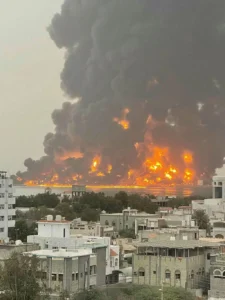With Israel’s First Ever Attack in Yemen, the War Takes a Dangerous New Turn Nine Months In

The strike in Yemen on Saturday.
After nine and a half months, the war between Israel and Hamas has crossed into what seems to be a new and much more dangerous phase. A drone launched by the Houthis from Yemen hit Tel Aviv and killed an Israeli citizen. A little more than 24 hours later, Israel Air Force jets struck the weapons depots, a power plant and oil refinery facilities near the Yemeni Red Sea port of Hodeidah, causing extensive damage.
This was the first time Israel struck in Yemen, after leaving military responses to previous Houthi attacks on it to the United States and the international coalition it led.
The strike’s successful outcome – at about 1,700 kilometers from Israel – sends a message of the Israeli air force’s long-range military capabilities to the whole region and especially to Iran, which arms and finances the Houthis. Nevertheless, it’s also expected to lead to Houthi retaliation attempts against Israeli targets. These clashes may raise the risk of an outbreak of a multi-front, much more intense war.
The launch of a drone from Yemen on Friday was a surprise. There was no advance intelligence warning, and it seems the defensive apparatus was also limited. A severe human error occurred in the Israeli air defense system: Although the drone was detected as it moved eastward for several minutes – flying from the Mediterranean Sea toward Tel Aviv beach – it wasn’t identified as a hostile target that requires interception.
It exploded near the U.S. Embassy building in Tel Aviv. A 50-year-old Israeli, Evgeny Ferder, was killed and eight others were wounded. As the drone wasn’t identified as hostile, no alarms were activated.
The air force is still investigating the circumstances of this malfunction (as it was a human error, maybe it’s better to say “mistake”). The Houthis, who claimed responsibility for the attack, used a drone that had a lesser weight of explosives on it to allow for maximum flying range. Its flight plan was also relatively unusual, as it seemed to have included crossing Egypt.
